After-hours action
Night-lights attract the coastal nighttime bite
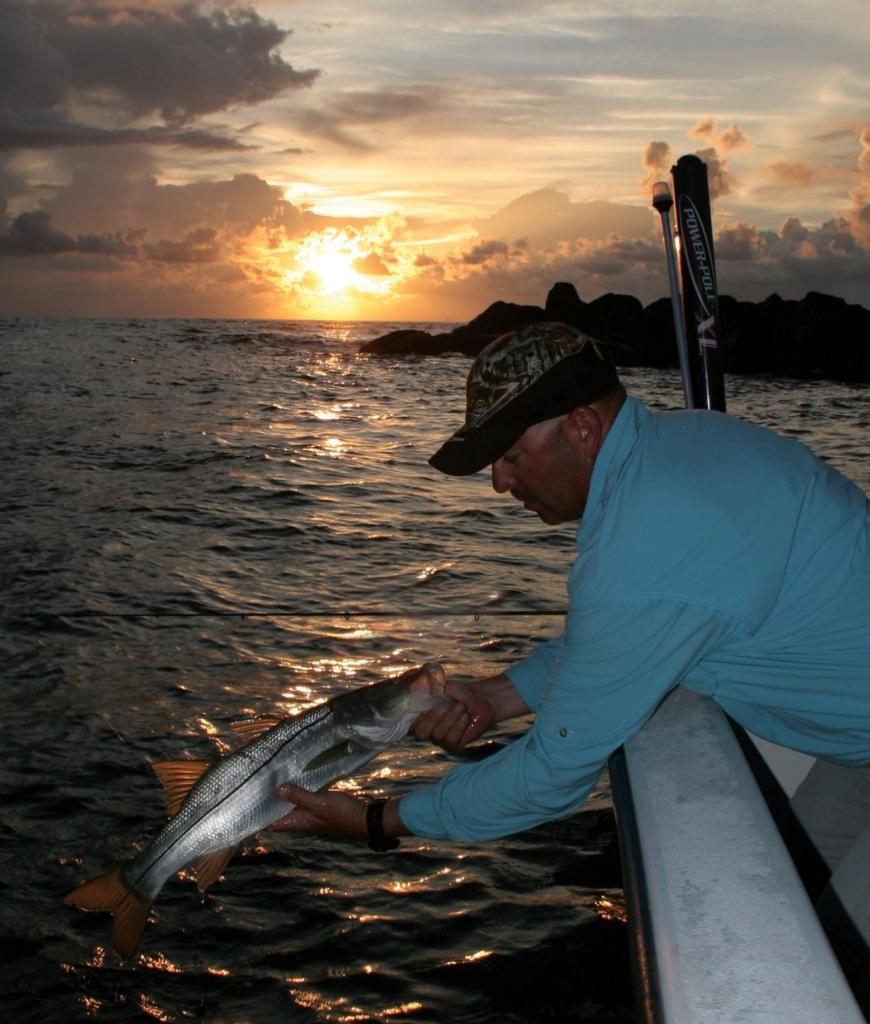
Black night – there is no moon, no stars, no distant horizon line, no sparkling ripples on surface water, just lightless primeval space extending far beyond boat gunwales.
Only the soft, subtle sounds of fish and fishermen alter a coastal night’s abysmal character. A subtle slap of sea bounces against skiff sides. The swish of cast lures slices air. The whir of turning reels and the splash of landing plugs ring. But the most startling and exciting sounds of all are the slurping, sucking and slamming strikes from seatrout, redfish, snook and other night predators.
This is what south Florida skiff guide Geoffrey Page of Venice, Fla., and I experienced one quiet summer night. Page, along with Terry Brantley of Arcadia, Fla., won the 2008 Wal-Mart FLW Redfish Series Eastern Division event in Sarasota, Fla.
“Hear that? Oh man, it’s going to be good. It’s going to be great,” Page said in the always upbeat and ready-to-go-fishing tone that infects everyone around him. “I didn’t know if we hit the tide right because I haven’t been night-fishing recently. But my buddies told me they’d been getting trout, big ones, plus a few redfish, and I thought we’d score. No doubt now, no doubt at all with those sounds of fish!”
Underscoring Page’s words, a fish boiled the surface loudly beneath a large halogen light on a dock that hovered just 3 feet above the water’s surface and 40 feet to the side of our skiff. Seconds later he cast upcurrent of the light with a glow-colored D.O.A. Shrimp rigged weightless. The bait touched down just as a second, third and fourth fish slurped at the surface, leaving telltale bubbles in their wakes. Then three or four trout dashed through the glow of the light, scattering tiny minnows that leapt before them out into the darkness.
“Look at that! It’s going to be something. There he is,” Page bellowed as his spinning rod bowed heavily with a fish.
Page battled the first of many seatrout and other species that fell to our lures that night. As he played his trout, I picked up a rod rigged with a small silver and blue Rebel Minnow. There were so many seatrout feeding ravenously, I figured a little surface-twitching lure would work well and be fun to watch get clobbered. I flipped the lure upcurrent of the light so it would float naturally into the glow close to the dock. As the lure neared the light beam on the water, several feeding seatrout cruised in and around the dock light, and occasionally one struck at small baitfish.
“They’re going to kill that plug,” Page said as he watched my lure swing in current while he unhooked and released his trout.
The plug floated into the light glow, I jerked it about three times, and then I let it rest – nothing. I began the lure action again, paused, then jerked. Still, I got nothing.
Finally, on the third action, the water exploded as a bigger, heavier fish we hadn’t seen under the dock clobbered the Rebel. The fish dove deep, cut right and left, tried to dart back under the lighted dock, but I was able to muscle it out. It raced toward deeper and darker water. A few minutes later, I finally had it near the boat where Page grabbed it – a fat and healthy 6-pound redfish.
A dozen trout, redfish and snook later, the action slowed around our fist dock. So Page cranked in his lure fast while pulling aboard his bow-mount Minn Kota.
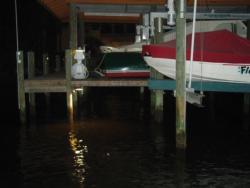
“Let’s try another dock,” Page said. “There are plenty of them, and most hold fish. It’s going to be a night to remember.”
Lure of the night
That night-fishing session with Page was one of many great trips I’ve made after dark for numerous species of marine game fish in many places. In fact, rare is the after-hours fishing trip I’ve made over the years that wasn’t great. This is because almost any inshore stretch of saltwater that’s productive during the day is at least as good at night. Deep channels, passes, shallow flats, inlets and jetties that offer fast fishing when the sun shines, frequently have much better action when the sun sets. The reasoning is simple. Shrimp, baitfish and other forage are more active at night – and so are predators that chase them.
It’s important to remember, too, that many species of sport fish, like striped bass, snook, seatrout and black drum, are light-sensitive, meaning they shy from direct sunlight, especially in ultraclear water. But at night, they’re on the prowl.
Beginning night anglers should consider working water they are familiar with, for reasons more than just locating the areas and getting home again safely. Obviously, places anglers fish frequently probably produce. Else what would be the point in fishing there frequently? And most anglers’ favorite spots are spots where they are familiar with the fish, baitfish presence, structure and cover. If they’ve only ever fished those spots during daylight, hitting them after sundown can provide a pleasant surprise. Getting started, the best bet is to head to the water before sunset if possible. Early arrival will make it easier to get oriented to the area.
Another major plus for night-fishing is there’s little competition from other anglers. This is a “cooler” time, too – much more comfortable than working the same hot-weather hot spots during the broiling heat of a summer day. Anglers who normally work in the day also should find inshore night-fishing much more relaxing and entertaining than flopping down in front of a TV after a tough work day.
A light approach
A light of almost any type will draw baitfish, shrimp, and ultimately, sport fish. So, inshore night anglers are wise to gravitate toward channel marker, bridge and pier lights that shine down into the water. Usually the best fishing around pier and bridge lights is late – after boat, car and people traffic has diminished.
All types of inshore fish can be found around lights. Snook, reds, jacks, tarpon, snapper, striped bass, seatrout, bluefish and others are regular inhabitants of night-lights. Sharks are notorious night feeders, 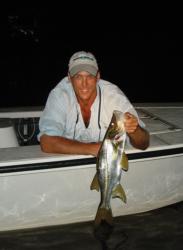 and they can be very aggressive feeding on seatrout, ladyfish and others drawn to bait schools around lights.
and they can be very aggressive feeding on seatrout, ladyfish and others drawn to bait schools around lights.
“Generally, the biggest inshore fish hold in shadows just outside a light’s strong beam glaring down into the water,” said Captain Ed Zyak of Jensen Beach, Fla., a Florida fishing guide and Wal-Mart FLW Redfish Series Eastern Division angler. “Fish dart into a light occasionally to swat wayward baitfish or shrimp. It’s common to see such fish waiting to ambush on the fringes of lights. So before you cast a spot, observe the place for a minute or so to get a better idea of fish location and the likely action you’ll encounter.
“Often the easiest way to hook the biggest `light’ fish is to wait until they make a feeding pass through an area. Time your lure or bait when fish are in a feeding flurry, and a hookup is almost guaranteed. But there are times when fish seen are not necessarily fish caught.”
Naturally, all lights on a bridge or long pier won’t be productive. But instead of working each spot and fishing barren water, it can be a good idea to drop one fisherman on shore, have him quietly walk up on a bridge or public pier, and gaze down into the water to locate fish under light beams.
“A lot of time can be saved this way, and it makes for especially exciting sport to know a huge snook, tarpon or pod of stripers is stationed near a light you’re casting to,” said Gulf Coast guide Captain Joel Brandenburg of Apollo Beach, Fla. “It’s also exciting to stand on a bridge and watch your pals cast, then observe fish stalking a lure and hitting it. Bridges and piers also offer outstanding night-fishing platforms for land-based anglers.”
All night-lights, of course, should be approached quietly, either by drifting in a boat with current or using a silent and easily controlled electric motor. Once in casting position, holding a boat still and quiet near a bridge abutment or piling is imperative to keep from spooking fish.
And in addition to the usual hot spots for inshore fishing, outstanding night action can be had at places virtually barren of game fish during daylight hours – and lights make the difference between finding those spots and striking out. Big, shallow, clear flats are good examples of where this works. For years flounder giggers have known they could cruise in boats, spot fish with bright lights and then gig flounder on sand flats that have almost no fish on them in the day. The same is true for sport anglers bent on catching a delicious flatfish.
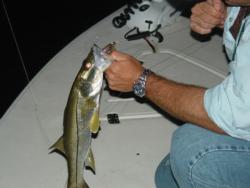 Slowly drifting or outboarding across a sand flat near a deep channel and scanning the bottom with a high-powered light is one of the fastest, surest ways of locating a flounder-filled flat. Often seatrout, red drum and other species are seen, too. Fish ease away from a light, but they don’t spook badly. Once a place has been found full of sport fish, work back up tide, drift and cast for them.
Slowly drifting or outboarding across a sand flat near a deep channel and scanning the bottom with a high-powered light is one of the fastest, surest ways of locating a flounder-filled flat. Often seatrout, red drum and other species are seen, too. Fish ease away from a light, but they don’t spook badly. Once a place has been found full of sport fish, work back up tide, drift and cast for them.
After-hours tackle
Simplicity is the order of the night, at least for fishing tackle used for catching redfish, seatrout and other species inshore. Use familiar gear and the best you own because tackle problems at night, particularly with hard-fighting fish, are not needed.
Most experienced after-hours anglers use medium-action spinning tackle. A 6 1/2- to 7 1/2-foot spinning rod with skirted-spool reel with 10- to 20-pound-test line is good. Quality braided line is preferred by many anglers for abrasion resistance and low stretch. Baitcasters should use their best outfits, especially reels, because a backlash is a time-wasting disaster at night. Always have a backup rod and reel or two quickly available should something go amiss with the primary tackle.
For terminal-end rigs, start with a Bimini twist or spider hitch at the line end, forming a 1-foot loop. Then tie on a 4-foot shock leader of 30- to 50-pound-test fluorocarbon. Connect lures and hooks directly to a leader, no hardware, and loop knots are preferred.
“Many different artificial lures score on night fish,” said Wal-Mart FLW Redfish Series Eastern and Western division angler Captain Blair Wiggins of Cocoa, Fla. “Two of my favorites are the D.O.A. Shrimp in a glow color and the D.O.A. TerrorEyz jig. I can cover the water column pretty well with these two lures, and they catch about anything that’s feeding around lights.”
Other standard night-light lures include the Bomber Long A minnow, MirrOlure Classic 52M sinking twitch bait, a soft-plastic jerkbait like the various Bass Assassin Shad lures, and a small surface plug, such as the Heddon Super Spook Jr., the Spit’n Image or the Swim’n Image. Many different styles and colors of grubs and bucktail jigs in 1/8- to 1/2-ounce sizes also are very effective.
“Most big fish are caught deep around night-lights of docks, piers and bridges,” Page said. “At times, big trout, snook and tarpon come up around docks and take lures and baits near the surface. But most of the heavy ones – especially redfish in the 5- to 8-pound range – are caught on or near bottom, usually with jigs or sinking plugs.”
Page and I caught our share of fish that night working beneath the glow of dock lights, but that wasn’t surprising. Fish are active at night – big fish – and when night-lights attract prey, finding the big biters can be quite predictable. With simple tackle and your favorite fishing spots, the night bite may provide the after-hours action you desire too.
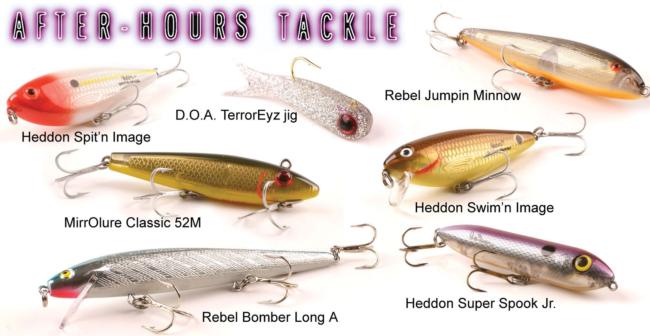
Night-lights
One obvious and negative part to night-fishing for many inshore anglers is they can’t see what they’re doing very well. So lines, leaders, hooks and other angling gear get fouled, and fishermen get frustrated quickly – often giving up in disgust even before giving after-hours fishing a fair chance.
The way to combat such nighttime blues, of course, is with a light or lights of some sort. Many veteran fishermen use portable, battery-operated headlamps, which allow for freedom of both hands for ease in tying knots, unhooking fish and performing other tasks.
A small, powerful flashlight that fits in a pants pocket is also a handy nighttime item, and everyone onboard should have one. It can be turned on easily and held between teeth for bright, focused light when both hands are needed, as when unsnarling backlash.
“By far the best I’ve used are ones made by SureFire, whose lights are prized by police departments and the military,” Captain Ed Zyak said. “The company makes a wide variety of small, powerful, rugged and waterproof flashlights, some of which come with small clips that easily attach to a shirt or pants pocket when two-hand work is required.
“My favorite SureFire flashlight is the G2 Nitrolon. While only about 5-inches long and powered by two small lithium batteries, its light is so bright it can be used to navigate inlet channel markers while skimming along at night in a boat on full plane.”
SureFire makes flashlight lens covers in red or blue that are not as spooky to fish as a bright white light, yet still offer plenty of illumination for anglers.
There is a tendency for some anglers to rig big, bright lights in small boats for night-fishing. But for accurate casting to docks, piers and bulkheads for seatrout, redfish, snook and others, too much light in a skiff can be a detriment. Bright lights high overhead in a boat can “blind” anglers and make it difficult to see fishing targets when casting. Sometimes just a simple, single, all-white stern “running light” is adequate, particularly when anglers are casting to dock lights, which flood fishermen with a good bit of soft light for easy boat maneuvering and safe walking around a skiff.
The best boat lights for dock-casting anglers are low-to-the-floor ones that are subtle, yet quickly accessible.
Florida skiff guide and Wal-Mart FLW Redfish Series Eastern Division angler Captain Larry Miniard of Ponte Vedra, Fla., uses a small, battery-operated lantern that has two small florescent bulbs. The portable lantern is attached with alligator clips to his boat battery and is stationed on the boat floor, near the console. It offers bright, low light that allows for good boat safety while fishing. Plus, when the need arises for acute light to tie on a new lure or hook, the lantern is just a couple of steps away from bow and stern decks.